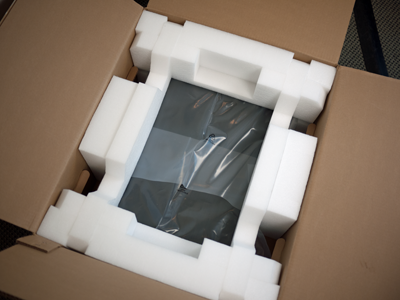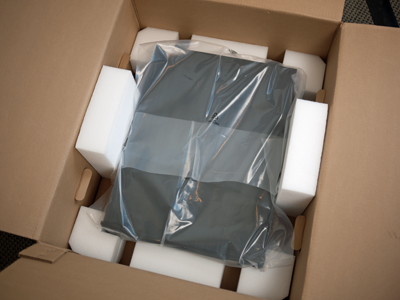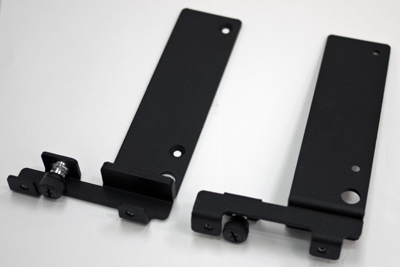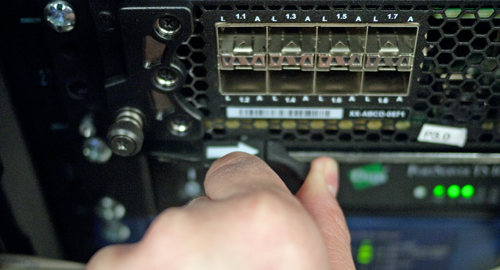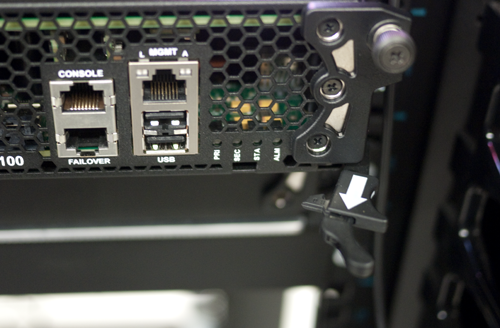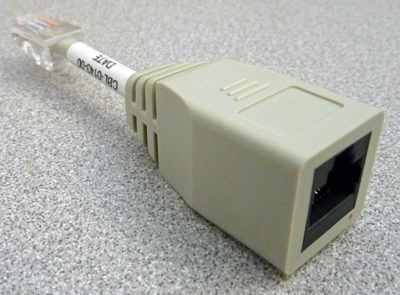Applies To:
Show Versions
Platform Installation
About installing the platform
After you have reviewed the hardware requirements and become familiar with the VIPRION® 2200 platform, you can install the chassis.
About general recommendations for rack mounting
Although not required, a 1U empty space between chassis makes it easier for you to remove the chassis from the rack in the event that the chassis requires service. A 1U space between chassis also provides additional cable routing options.
Leaving at least 100 mm of space from the front panel of the chassis to the rack front or rack door provides enough room for you to route the cables without excessive bending or insulation damage.
A shelf or similar device is required to support the chassis if only one person is installing the chassis.
Hardware included with the AC-powered chassis
The VIPRION® 2200 Series AC-powered chassis should include all of the hardware components listed here.
| Quantity | Hardware |
|---|---|
| 2 | AC power cables (C13 to NEMA 5-15P) |
| 2 | Two-point rack mounting brackets |
| 1 | Four-point rack mounting rail kit (includes two rail assemblies, eight #8-32 thumb screws, and two cage nuts) |
| 2 | Four-point rack mounting brackets |
| 6 | M3.5 patch screws |
| 2 | Cable routing brackets |
| 2 | Cable management covers |
Hardware included with the DC-powered chassis
The VIPRION® 2200 Series DC-powered chassis should include all of the hardware components listed here.
| Quantity | Hardware |
|---|---|
| 2 | DC connectors |
| 2 | Two-point rack mounting brackets |
| 1 | Four-point rack mounting rail kit (includes two rail assemblies, eight #8-32 thumb screws, and two cage nuts) |
| 2 | Four-point rack mounting brackets |
| 6 | M3.5 patch screws |
| 2 | Cable routing brackets |
| 2 | Cable management covers |
Hardware included with blades
VIPRION® B2000 Series blade should include all of the hardware components listed here.
| Quantity | Hardware |
|---|---|
| 1 | RJ45 to DB9 console port cable (beige) |
| 1 | RJ45F to RJ45M rolled adapter (beige) |
| 2 | SFP+ 10G transceiver modules (B2100 and B2150 only) |
| 1 | Electrical static discharge (ESD) strap |
Peripheral hardware requirements
For each platform, you might need to provide additional peripheral hardware. If you plan to remotely administer the system, it would be helpful to have a workstation already connected to the same subnet as the management interface.
| Type of hardware | Description |
|---|---|
| Network hubs, switches, or connectors to connect to the platform network interface ports | You must provide networking devices that are compatible with the network interface ports on the platform. You can use either 10/100/1000/10000-Megabit or 40/100-Gigabit Ethernet switches. |
| External USB CD/DVD drive or USB flash drive | You can use a USB-certified CD/DVD mass storage device or a USB flash drive for installing upgrades and for system recovery. Note: F5® recommends that external CD/DVD drives be externally powered.
|
| Serial console | You can remotely manage the platform by connecting to a serial console terminal server through the console port. Important: In the event that network access is impaired or not yet configured, the serial console might be the only way to access the chassis. You should perform all installations and upgrades using the serial console, as these procedures require reboots, in which network connectivity is lost temporarily.
|
| Management workstation on the same IP network as the platform | You can use the default platform configuration if you have a management workstation set up. |
Unpacking the chassis
About installing the chassis
You should select a location for installing the VIPRION 2200 chassis that is easy to access for adding or removing power supplies, the fan tray, or blades. The location should also provide adequate ventilation to allow sufficient airflow through the platform. The platform employs a negative pressure fan system, which draws cold air in from the front of the chassis and exhausts hot air out the back of the chassis. After you have identified the intended location for the platform, you can install the chassis into the rack.
The chassis is designed for 19-inch racks. If you are installing into a wider rack, you will need to provide adapters. The four-point rack mounting rail kit will not work with 23-inch racks.
About the two-point rack mounting brackets
You can use the two-point rack mounting brackets if you are installing into a two-post rack.
Installing the two-point rack mounting brackets
About the four-point rack mounting rail kit
The four-point rack mounting rail kit helps ease installation and removal of the chassis from a rack. The rails snap into place in the rack, and no tools are required to install a platform using this kit. The rails are optimized for installation into square hole cabinets, but they can be installed in other cabinet styles, such as round hole cabinets, using the screws provided. The rails are easily converted to mount to either cabinet style.
The rail kit includes these parts:
- Two rail assemblies (left and right), which consist of an inner rail that you install onto the chassis and an outer rail that you install in the rack
- Eight #8-32 thumb screws
- Two cage nuts
Before you install this platform, review the environmental guidelines to make sure that you are installing and using the platform in the appropriate environment.

Four-point rack mounting rails

Four-point rack mounting rail kit thumb screws and cage nuts
For information about installing the platform using the four-point rack mounting rail kit, see the instruction guide provided by the manufacturer, which is included with the kit hardware. After you slide the unit into the rack, use the thumbscrew on the bracket to lock the unit in place. If the thumbscrew does not reach the rack cage nut, insert a customer-provided rack screw through a slot in the bracket to lock the unit to the rack.
After the chassis is installed into a rack, you can install the four-point rack mounting brackets.
Installing the four-point rack mounting brackets
Installing the cable management system
About grounding the chassis
You should ground the platform after you install it in a rack.
Do not secure multiple bonding or grounding connectors with the same bolt. The grounding connectors do not need to be removed to perform service or installation procedures. You can connect other bonding or grounding conductors to a grounding connector provided a reliable bond between the connector and the equipment is not disturbed during installation, service, or maintenance of the platform.

AC-powered chassis grounding stud
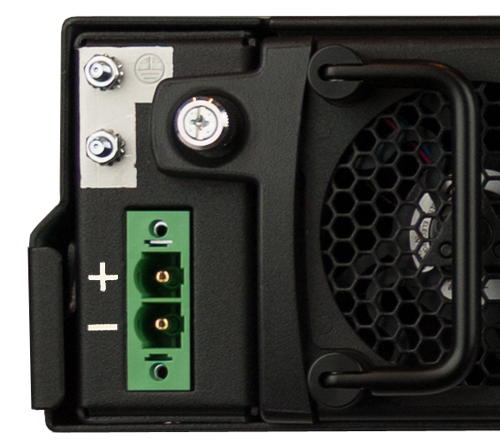
DC-powered chassis grounding studs
Connecting the chassis grounding stud to the ground terminal
You will need these tools to properly ground the chassis:
- Crimping tool
- Single (AC) or double (DC) ring ground terminal lug
- For either AC or DC installations, one 14 AWG copper wire long enough to reach from the chassis to the common bonding network (CBN)
About powering the VIPRION 2200 AC platform
The AC platform ships with two power cords that you must use with the installed power supplies to power the chassis.
Powering the AC platform
About powering the VIPRION 2200 DC platform
If you ordered DC power as a factory option, your VIPRION® 2200 platform comes pre-installed with DC power supplies.
Before you power this VIPRION DC platform, see Guidelines for DC-powered equipment and Guidelines for VIPRION DC platform installation.
Connecting DC power to the platform
About installing blades
When you initially receive the chassis, the slots that can contain these blades are filled with blanks. A blank must be installed in each empty slot to ensure proper thermal management and regulatory compliance. To add a new blade, you first remove the blank from the corresponding slot and then insert the blade. Be sure to keep the blanks in case you need to change the blade configuration later. You should not operate the chassis for an extended period of time without all slots populated.
Removing a blank
Removing a blade
Installing a blade
Connecting the cables and other hardware
After you have installed the chassis into the rack, connect the cables and other hardware.
You can now assign a cluster IP address to the system, and then license and provision the software.
Optionally, you should run the latest version of the qkview utility. This utility collects configuration and diagnostic information about your system into a single file that you can provide to F5 Support to aid in troubleshooting. For more information, see http://support.f5.com/kb/en-us/solutions/public/1000/800/sol1858.html.
About cluster management
The management IP address for a cluster is known as the cluster IP address. The cluster IP address enables you to access the browser-based Configuration utility to configure other aspects of the product, such as the product license, VLANs, trunks, and so on. Connecting to the cluster IP address connects you to the primary blade in the system.
With VIPRION® platforms, you assign cluster IP addresses on a per-cluster basis. Initially, all blades installed in the chassis belong to a single default cluster. During the initial setup, you only need to assign a single cluster IP address.
A blade within a cluster is known as a cluster member. You can assign a management IP address to each cluster member.
You can manage clusters using these methods:
- USB LCD module
- config utility
- tmsh commands


